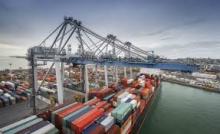NZ Herald: Investment expert questions Ports of Auckland's dividend source

4 April 2019
An investment chief has questioned the Ports of Auckland's dividend policies, saying it can only pay Auckland Council's annual return by borrowing more.
Chris Gaskin, a portfolio manager at Devon Funds Management, challenged the idea that the port should be retained because it paid regular money to the council.
"The port doesn't really pay a $50m dividend to Auckland Council. It has nothing left over to distribute. The port borrows from the bank to pay the council. It would probably be cheaper in terms of the rate payable or interest cost if the council just borrowed another $50m from the bank itself," Gaskin said.
The Herald reported on March 27 that Government was about to decide whether to move the port to the economically deprived Northland region. Two major reports are landing on ministers' desks for decisions on that and upgrading rail to the north for freight services and New Zealand First leader Winston Peters gave a "cast-iron commitment" in 2017 to move the port if his party was in a position of influence after the election.
Mayor Phil Goff's warned on any decision to move the port, which is 100 per cent owned by the council and which he said delivered a dividend of more than $50 million annually.
But Gaskin questioned the source of those annual dividends.
"Ports of Auckland can only pay $50m to the council by increasing debt," he said.
But a port spokesman said the business disagreed with Gaskin.
"Most companies carry debt and pay dividends at the same time. It's normal. At times debt will increase, as it is for us at the moment as we gear up to handle Auckland's rapidly growing freight demand. Debt will reduce again once this investment phase is over. We're not borrowing to pay a dividend. We're borrowing to increase capacity," the port spokesman said.
Gaskin said that last year, the port's net debt increased from around $297m to $384m.
"This is because, even before paying a dividend to the council, there was less money coming in via operating cash flow than was going out in investing cash flow," Gaskin said.
"To give you some context, the metric that is typically used to assess the amount of debt a business has, is net debt divided by earnings before interest, tax, depreciation and amortisation. This ratio for Ports is now 3.9 times, which is high.
"The same ratio is only 2.6 times at the larger and more diversified Port of Tauranga, and only 2.2 times at the Port of Napier which has wisely decided that 2.2 times is a sensible level of debt, and are planning to partially list on the NZX with the council retaining 55 per cent," Gaskin said.
NB: This was originally posted by NZ Herald on 30 March 2019. The link to the original article can be found here.





